|
Article on matchholders
published in "De Verzamelkrant" 1997 |
| |
Introduction
In general, match holders are metal boxes in which
matches were stored, provided with an abrasive surface to light the matches. A match holder is also a matchbox
in a slice or grip. As matchboxes were frequently used, the wooden boxes suffered so much damage that soon they
couldn't be used anymore for striking the matches. As a cure, the box was put into a slice. There are holders
for not only matchboxes but also for matchcovers (folded cardboard covers with break-off matches provided with
a strinking place to light the matches). At present, my collection comprises about 450 holders in all forms
and measures, made from all kinds of materials, for instance plastic, tin, metal, aluminium, copper, wood,
silver, porcelain etc..
|
History of the holder
The history of the match holder starts in the 19th
century. When matches were invented in 1830, people immediately tried to think of how to transport these
"dangerous" things. The first match holders were produced as early as 1835 and were made of wood; later iron
and other materials were used. The simple match holders were made for the common people. Only the wealthy could
afford expensive holders (made of silver and richly ornamented).
|
Sorts
Match holders can be divided into various forms:
Vesta cases,
Three-piece boxes,
Trick or Puzzle boxes,
The candle in the box,
Holders for normal and domestic matchboxes (grips, slides),
Holders for matchcovers,
Stand-alone houders,
Wall-suspended match holders
These forms can be further divided into even more subgroups. I'll discuss each of these forms separately
to give you an idea of the origin of the match holders and how its appearance.
|
|
Vesta cases: most of them come
from England and were made since 1880. On the bottom side of vesta cases there is an abrasive surface on
which you can strike a match. A vesta case consists of 2 parts: one hinge to take off the matches and one
body including the abrasive surface. In the first years of producing they were made of cheap materials such
as aluminium, brass, copper. A lot of nice cases were produced in this period. Later, also silver and even
gold was used for making vesta cases. Most vesta case have a ring to put the case on a chatterlaine. After
several years vesta cases were also produced in other countries for instance, the USA, Canada, the
Netherlands, etc.
| 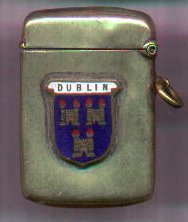 |
Three-piece boxes: consist of
3 part. One top (generallyy the hinge) a mid-body (the place of advertising) and a bottom (the abrasive surface).
The first boxes were also made in the early 1880's, an most of them by Charles Parker Co. (USA). Later this form
went to England and was used mostly used for advertising purposes. Most boxes of this form were distributed
between 1900 and 1915 and came from USA and England.
| 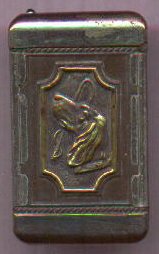 |
Trick or Puzzle boxes: these
are boxes that one cannot see how it opens; all have a nice trick to open it. The first samples of trick boxes
came from a person named Alfred Pearce (UK), who patented this form in 1899. The trick or puzzle boxes looked
outside like something else instead of a matchboxholder. Some of the trick boxes were made especially for
magicians. One trick box from the USA features the following text: "Finding the hidden spring depends on which
side you push. Send us a letter; that will bring you more success." So if you failed to open the box, you could
send a letter to the distributor of the box to get the solution.
| 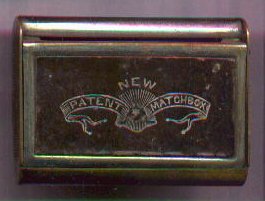 |
The "Candle in the Box" comes
with a candle and matches in one box. The first boxes were produced around 1850 and were used especially for
travellers. Most hotels the slept in had no lights, and the "Candle in the Box" enabled them to read or write
in the evenings. The candle could be put on the holder by means of a collapsible stand. An other form of this
box entered the market in 1880: this was a matchbox with a hole in the top in which you could stand a candle
(candle and match in one) The boxes were made from paper and mostly made in Italy and Belgium.
| 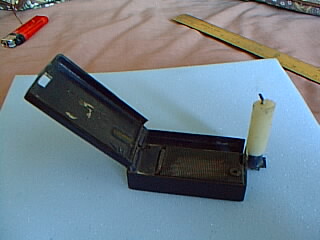 |
Holders for normal and domestic
matchboxes (grips, slices): were first made when the matchboxes were made of wood (after a few years
a standard size for matchboxes came up). This set off the demand to provide these matchboxes with slices.
All this happened in 1873. The first useable form was made by Bryant & May. Bryant & May produced from 1875
untill 1930 different types of holders, in different variations. They made 4 different forms. Since 1880
there were different manufactures who made these match holders. Even in the beginning of the 1920's the
match holders came from China; they exported them to North-America and England. The oldest match holder in
my collection came from Germany and is dated 1893. This holder has a monogram (HB) on the front and on the
back the following text: "1868 24/III 1893". It's a very big problem to date the match holders. Silver match
holders can be dated by the maker's mark. The following different forms of these holders were made:
holders for very small boxes
holders for pocket size boxes (about the size of the Swallow boxes)
holders for normal size boxes
holders for domestic-size boxes
The oldest match holder for domestic boxes were made in 1919 and is made of copper and has a picture of an owl.
I do not know where it comes from. |
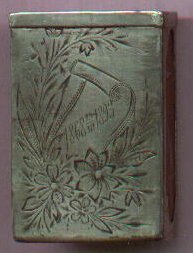
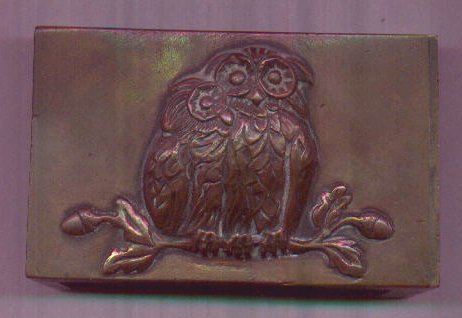
|
Holders for matchcovers: were
made a few years after the matchcovers were introduced and the need for special holders came up. A mister
Harold A. Dodge form New Jersey (USA) is probably the first person who patented this form. This took place
in 1903. Afterwards there were a lot of people who patented this sort of match holder as did Emanuel Ciner
from New York in 1908. The first holders that were found looked like the form which was patented in 1908.
This holder had also a cigar knife in it.
| 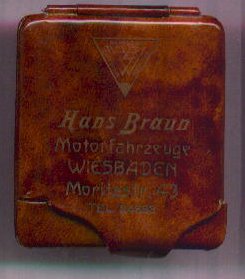 |
Stand-alone holders: are holders
that stand alone which explained the word already. Most of these holders don't have a lid and are bigger than
the holders I discussed above. They were used mostly as showcases. The first holders of his type were made 1870.
In general, these holders were figures with a hole in them to put in a match, so it looked as if the figure had
a candle in his hand. The most common forms are, ashtrays with a holder in the middle or on the side, a pot in
which you can place matches with an abrasive surface on the side of these pots., holders with room for a candle
and a matchbox. The oldest form dates back to 1875 and was made in England. Holders formed also part of smoker's
sets(tray, astray, cigarette holder and match holder) and may be placed in this group. Most match holders have
a stand to put the matchbox in which opened a little bit, so one could see the matches. There are many forms:
from figures, astrays. pots, with abraive surfaces, glass spheres. figures made of porcelain and ceramics, etc.
| 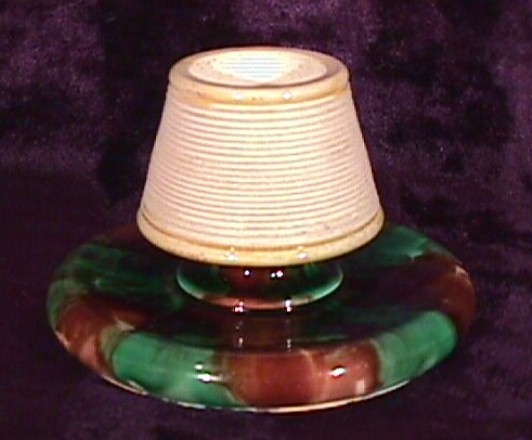 |
Wall-suspended match holders: are
usually rather large. Most readers know these pieces, they are generally found in the kitchen. The first types
were made in 1860 and were rather popular in America but not in Europe. The early ones were made of iron and were
produced in Germany around 1865. Later on, they were made from cheaper materials such as wood, plastic, and even
carboard. The oldest form in my collection came from Urk (the Netherlands) with a hand-written date on the back
that says 29/7-'38. Most holders found in The Netherlands were part of a set, that consisted of a coffee filter
holder, a notepad and the wall-suspended match holder.
|  |
Literature
Up until now very little has been written on this subject. The only book I have at present is "Match holders,
100 year of Ingenuity" by Denis B. Alsford,, published by Schiffer Publishing Ltd. This book enabled me to write
this small piece of history.
|
Afterword
This is my second article on the subject of match holders. I collect match holders as well as matchbox labels,
boxes and covers. I have learned more about the history and sorts of match holders, but some questions remain
unanswered, for instance:
which companies produced match holders in The Netherlands?
does propaganda material exist in which the match holder is promoted?
does more information and documentation about the match holder exist?
etcetera.
Should any reader of this article have an answer to these questions and/or is interested in trading match holders
and matchbox labels, please contact me by e-mail or write.
|
Literature list
Matchholders, 100 years of ingenuity,
Denis B.
Alsford,
Schifferbook,
ISBN: 0-88740-633-5
Pocket matchsafes, Reflections of life & art, 1840 -1920,
W. Eugene Sanders, Jr & Christine C. Sanders,
Schifferbook,
ISBN: 0-7643-0324-4
|
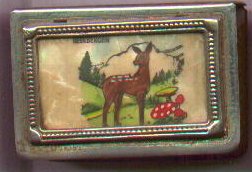
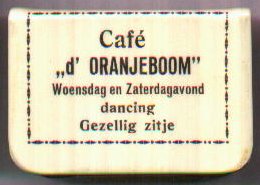
|
| |
|
 |


